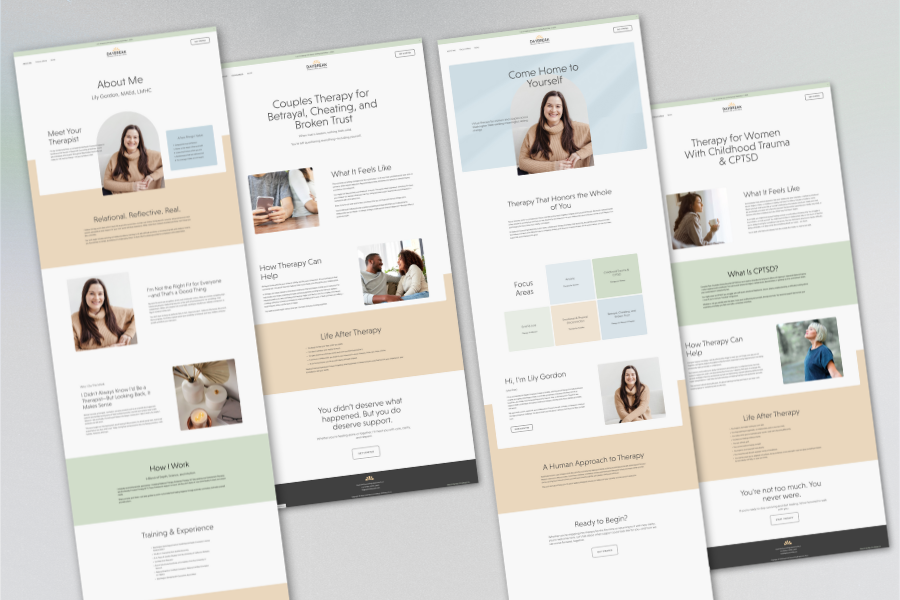How to Use Your Therapy Website to Screen Out Clients Who Aren't a Good Fit
How to Use Your Therapy Website to Screen Out Clients Who Aren't a Good Fit
Let’s get real: We don’t like to work with EVERYONE.* We have certain types of clients we really enjoy working with. Fielding calls from clients you can’t or don’t want to work with can take up a lot of time and energy.
If you’re looking for ways to attract your best-fit clients, be sure to read this post: How to Attract Dream Clients Using Your Website
The problem is, the general public doesn’t always recognize that therapists aren’t going to be effective with all problem areas or all types of people. One big reason for this is that therapists don’t do a good job of clearly stating their areas of clinical focus.
Your website is a great way to do this. Here are 3 tips for using your website to screen out clients who aren’t a good fit for you.
1. Be Clear About Your Niche
As I mentioned in How to Use Your Website to Attract Your Dream Clients the first important rule for any therapy website is to be explicit about which clients you work with. If a potential client doesn’t connect with what you’re stating in your website, they are less likely to call.
Don’t have a niche yet? This article might help: A Creative Way to Choose a Niche
This doesn’t mean sneaking broad keywords (like anxiety, loss, transitions, relationship problems) into lengthy paragraphs and expecting your audience to deduce that you only work with anxious adults who are experiencing job loss.
Instead, be specific about straightforward when writing about your your focus area/niche Here are some ways to do this:
Your home page headline - When your headline is used to emphasize your niche, it’s like screaming “I AM THE BEST THERAPIST FOR YOU!” the moment they land on your website.
A bulleted list - It’s difficult to write copy that’s compelling enough to hold your audience’s attention. So, if your website is a little boring or psycho-babbly, it will only get scanned. However, people tend to stop and read bulleted lists.
A “Who I Work With” section or page - When you dedicate an entire page or section and give it an unambiguous title like, “Who I Work With,” your audience will notice.
All over your website - Okay, this strategy isn’t as simple, but keep in mind that having niche-specific keywords throughout your websites improves your SEO (search engine optimization). In other words, when potential clients type into Google descriptors that are all over your website, search engines will more precisely point your best-fit clients to you.
2. Explicitly State Who You Don’t Work With
This might seem obvious, but most therapists don’t do this. They worry about deterring too many clients or they try to look so inclusive that they shy away from setting a tone of exclusivity at all.
Even if you’ve stated your niche/specialty area, there are going to be clients who don’t read between the lines; who don’t recognize that they still don’t fit within one of your categories. This can happen if your niche is pretty broad or you didn’t follow my recommendations above. This can also happen if your potential client doesn’t actually read your website copy.
If you’re frequently fielding inquiries from people who didn’t seem to read your website content, be sure to read my post about Copy Writing Basics for Therapy Websites. Your copy might be too long or not compelling enough to hold your audience’s attention.
So, go ahead and state clearly who you don’t work with. It’s okay, you’re not going to hurt anyone’s feelings. It also sets a tone of specialization and your clients want to know you can help them.
Here’s an example from a therapist who doesn’t want to provide crisis services or work with people with severe mental illness:
“While my psychological approach is effective for a broad range of problem areas, I do not work with people with severe and persistent mental illness or those needing between-session intervention.”
Here’s another example from a therapist who only works with clients with addiction:
“The bulk of my training and experience is in addiction and recovery services, therefore I ONLY work with clients and families experiencing substance use disorders.”
3. Use a Contact Form as a Screening Tool
I generally recommend that therapists don’t plaster their phone number, fax number, and email address all over their website and use only a contact form for new client inquiries.
There are many reasons for this, but one is that the form itself can screen out clients who don’t fit within your defined treatment population. It can also deter clients who need to use insurance and have a plan you don’t take.
As you can see on my contact form below, potential clients are required to select which of the four client categories they belong to. They must also select their insurance company or be forced to indicate that they aren’t using insurance. I even go so far as to require they write down their insurance information so that I can verify that they’ve selected the right option.
If the potential client indicates that they don’t fall into one of the four client categories or they want to use an insurance plan I am not contracted with, I can send a quick email stating that I won’t be a good fit for them or I don’t take their insurance. This is much faster than figuring this out through a phone call. But seriously, I rarely have to do this because my form does this for me.
Lastly, there’s a field on my contact form that asks clients to share how they heard about me. This wasn’t intended to be a screening tool, but it turned out to be a helpful one! I discovered that a doctor in my town was sending me a variety of patients that did not fit within my niche. This provided an opportunity to contact the doctor and clarify who I work with.
As you can see, there are simple ways to use your website as an effective screening tool. The better you are at attracting your best-fit clients, the more effective you will be as a therapist. Better screening also means fewer unnecessary phone calls (and the phone-tag that comes along with them), more time with the clients you’re best able to help, and a website that keeps attracting your dream clients.
*It’s tempting, especially when you’re first starting out, to take every client who calls you, no matter what they need. Do not do this. If you’re taking every client who calls you, then please – for the safety of your clients and the longevity of your career – get more clinical training, hire a supervisor, and/or identify the clients you are best able to help right now. It is not ethical for you to work with someone with a presenting concern you don’t know how to treat. You’d be doing the client a real disservice because there is likely another therapist who can be effective with the client (which means the client doesn’t suffer as long) and you could cause harm to the client. When your caseload is aligned with your niche, 1. Your clients will make more progress because you know how to help them, 2. You’ll reduce the likelihood of doing harm, 3. You’ll feel more satisfied and fulfilled in your career, 4. You’ll be less likely to experience burnout so you can keep doing the work you love.
Level Up Your Practice is a design and digital marketing company in Gig Harbor, WA. Level Up specializes in websites and digital marketing solutions for therapists, counselors, and coaches.































